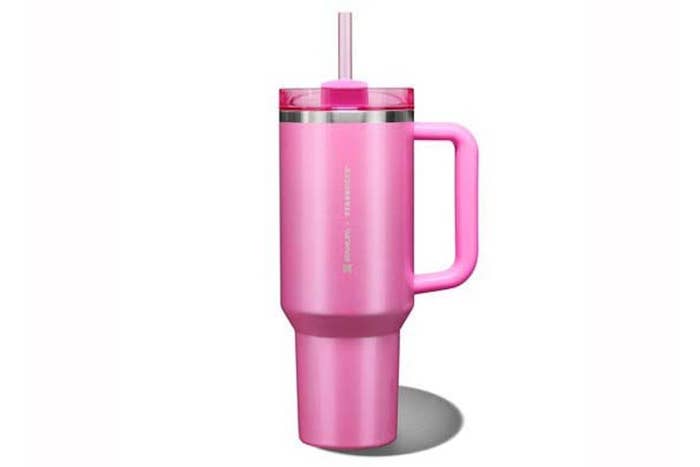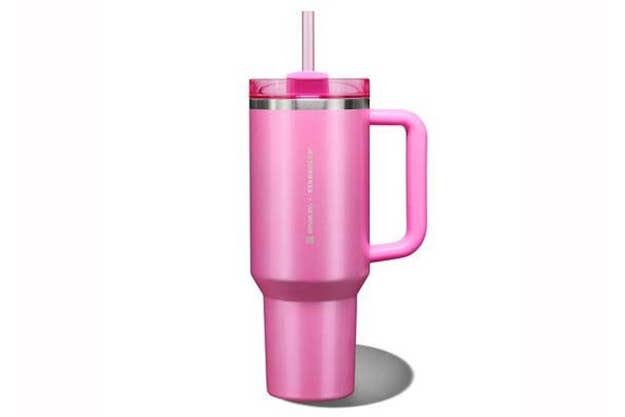
Yes, Stanley cups, those gigantic metal tumblers, are quickly becoming the most hyped accessory to own in 2024.
Recently, videos showing dozens of shoppers mobbing Targets to buy Stanleys have gone viral on social media. On Jan. 3, the hype reached new heights with the release of another collaboration between Stanley and Starbucks.
The limited-edition Stanleys, which came in pink, were exclusively sold at Target for $45 and garnered early-morning lines at stores across America. One viral video shows a Stanley fan attempting to shoplift them before getting tackled and beaten by other customers who waited in line for hours. The cups sold out quickly and are now being resold for as much as $200 on StockX and eBay.
So why are Stanley cups being treated like Supreme box logos, PlayStation 5s, and Air Jordans right now? Here’s the hype behind Stanley, explained.
What Are Stanleys?
@victoria_robino_26 #fyp #fypシ゚viral #target #targetfinds #stanleycup #stanley #stanleytarget #valentinesday #stanleyvalentinesday
♬ original sound - Victoria Robino
How Did Stanleys Become Popular?
@tatiana.teaBut the Quencher’s fate changed when Stanley recognized that Quenchers were a popular item promoted on The Buy Guide, an e-commerce blog and Instagram page centered on women. Instead of restocking Quenchers on its own webstore in 2019, Stanley tested a different market by seeing what would happen if The Buy Guide placed a wholesale order to sell 10,000 Quenchers directly to its followers. According to Retail Dive, The Buy Guide sold 5,000 cups within four days. When it restocked the next 5,000, they sold all of them within an hour. It has since led Stanley to not only sell the cups on its own webstore again in 2020 but to continue working with The Buy Guide and other influencers within the women’s lifestyle space. Since then, Stanleys have become a ubiquitous water bottle on TikTok that’s typically co-signed by young women.
What’s So Special About The Stanleys Sold at Target?
Another component fueling the hype for Stanleys are limited-edition collaborations. When Stanley was working with influencers like The Buy Guide, it also hired Terence Reilly to be its new president in May 2020. Before joining Stanley, Reilly worked at Crocs for seven years as its chief marketing officer and helped reinvent the brand as a hyped footwear label. Like Crocs, Reilly has used collaborations and limited drops to build a collector’s community around the product.
“My experience at Crocs was fueled by collaboration culture and drop culture,” Reilly told MSNBC. “And I knew that once we had our legs under us at Stanley, and once we could see the connection to consumers that we were creating, we were also ready for collaborations.”
Since 2019, Stanley has released Quencher collaborations with celebrities like Lainey Wilson and beauty brands like Olay. Quenchers that are released at Target are so hyped because the big box store has been the exclusive retail partner for many of these collaborations. According to MSNBC, Stanley’s annual revenue has only grown since 2019. It doubled from $94 million in 2020 to $194 million in 2021, to doubling again to $402 million in 2022.
Are Resellers Really Flipping Stanleys on StockX?
Ain't no way they're selling Stanley cups on StockX now 💀 pic.twitter.com/8LBUNLRhoH
— Complex Sneakers (@ComplexSneakers) January 3, 2024
Like anything else that has garnered a lot of hype and resale value, the popularity of Stanleys has led to the creation of many off-brand knockoffs. What’s nuts is that there are even Stanley Quenchers replicas being sold on the market today. Stanley has addressed the proliferation of dupes on its own blog and has urged consumers to stick to the real thing instead.
Why Do People Collect Them?
@mia_lovespink how many stanleys do you have? @Stanley 1913 #stanleycup #stanleycupcollection #blowthisup #viral #fypシ゚viral #fyp
♬ original sound - r & m <3 ⸆⸉<>>
One reason why the cups are so collectible is because of artificial scarcity. Stanley President Terence Reilly told MSNBC that Stanley did “want a little bit of scarcity” to maintain the hype around Quenchers. “We really continue to increase the number of units available each time we drop, because we see the trend and the waiting lists that are growing,” he told MSNBC. “But there’s only so many seats in the stadium, and when the seats are sold out, they’re sold out.” In an interview with The Guardian that sought to explain the phenomenon behind collecting Stanleys, Reilly also told the paper that Stanley originally released Quenchers in only five colors but now releases limited-edition colors monthly to embrace collectors.
Rachel Makar, a senior merchandising director at StockX, sees the collecting frenzy around Stanley Cups as another example of a trend creating supply and demand that’s also growing with a scarcity model.
“This is yet another example of a product that fits that bill for the current culture consumer. The broader cultural shift toward an obsession with hydration also doesn’t hurt—the hashtag #WaterTok has 975 million views on TikTok, and just last week The New York Times predicted premium hydration will be a major trend in 2024,” says Makar. “What we’re seeing play out on the platform is a bit of a perfect storm of the scarcity-fueled hype, the right brand partners, and a moment in time where hydration is top-of-mind.”
While it’s impossible to ascertain why anyone collects anything, only time will tell how many Stanley Cup collectors will be around once the hype dries up. But who knows, maybe we’ll see Stanley Quenchers released by Kith or Supreme in the near future.
SHARE THIS STORY

